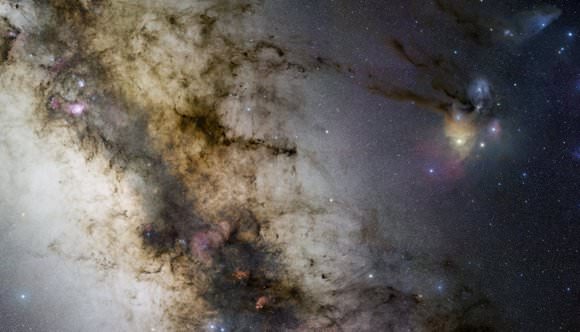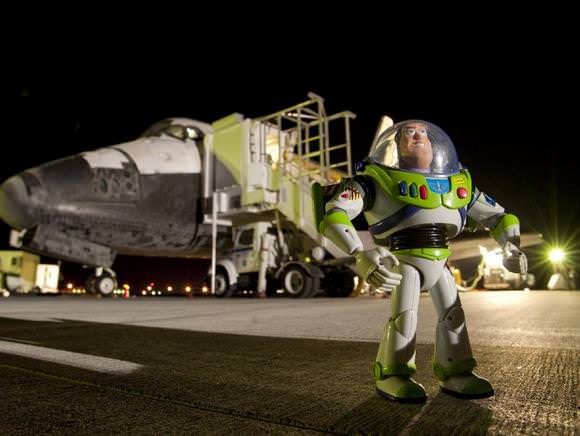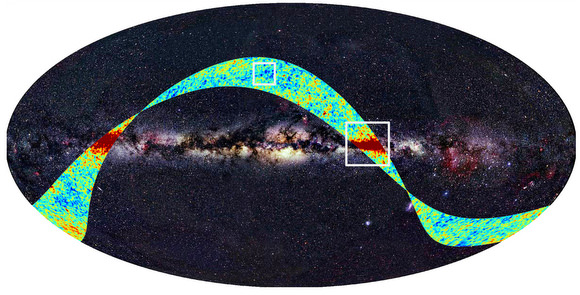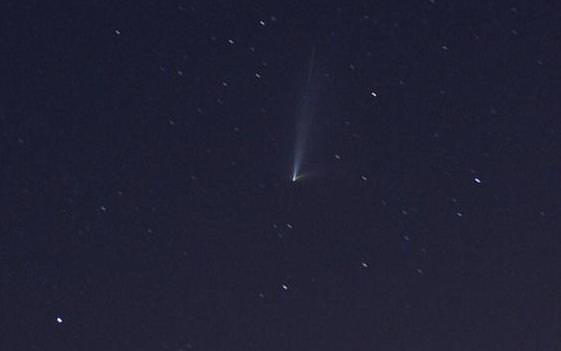340 Million Pixels of GigaGalaxy Zoom
Last week the GigaGalaxy Zoom project introduced an interactive 360-degree panorama of the entire night sky, and they promised more zoomable images to come. The second of three images is now available, and it is a wonderful 340-million-pixel vista of the central parts of our galactic home. Taken by Stéphane Guisard, an ESO engineer and world-renowned astrophotographer, the image shows the region spanning the sky from the constellation of Sagittarius (the Archer) to Scorpius (the Scorpion). This mosaic was assembled from 52 different sky fields made from about 1200 individual images totalling 200 hours exposure time, with the final image having a size of 24,403 x 13,973 pixels. Click on the image to get access to larger versions of the image. Jump right in and enjoy the views!
(...)
Read the rest of 340 Million Pixels of GigaGalaxy Zoom (165 words)
Why is Mars Red? New Study Offers Surprises
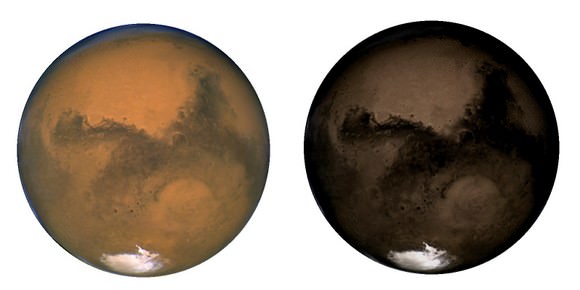
Is Mars red due to rocks being rusted by the water that once flooded the red planet? And is the only explanation for the hematite found by Mars orbiters and studied by the Mars Exploration rovers is that water once was present in volumes on Mars? Not necessarily, says a new study. Research done by Dr. Jonathan Merrison at the Aarhus Mars Simulation Laboratory in Denmark shows that the red dust that covers Mars may be formed by ongoing grinding of surface rocks. Liquid water need not have played any significant role in the red dust formation process.
(...)
Read the rest of Why is Mars Red? New Study Offers Surprises (533 words)
New Equinox Stunners From Cassini
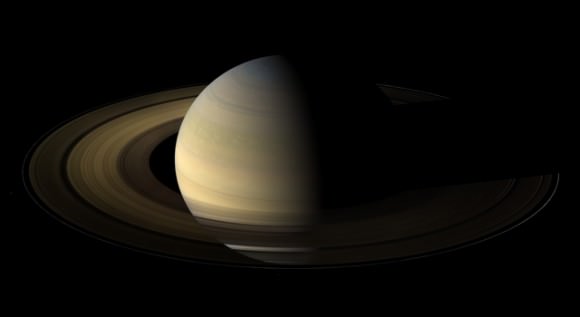
Every 14.8 Earth years, equinox occurs at Saturn. But this is the first time there has been a spacecraft in situ to watch what happens when the sun is directly overhead at the equator, illuminating the rings directly edge-on. New images compiled from the Cassini spacecraft show a rare and breathtaking display of nature: the setting of the sun on Saturn's rings. The image above — a mosaic of 75 different images — shows the beauty of this ringed world, but the most surprising revelation from these new images are that newly discovered lumps and bumps in the rings are as high as the Rocky Mountains.
(...)
Read the rest of New Equinox Stunners From Cassini (703 words)
NASA Science News for September 21, 2009
Using a colossal radio telescope in the Mojave Desert, school kids around the world are helping NASA track the LCROSS spacecraft as it heads for a crash landing on the Moon.
FULL STORY at
http://science.nasa.gov/headlines/y2009/21sep_gavrt.htm?list1035898
NASA Has a Little Fun With Buzz
Buzz Lightyear, that is. The action figure returned from space on Sept. 11, aboard space shuttle Discovery's STS-128 mission after 15 months aboard the International Space Station. Word has it that Disney is quite excited about his return, and will give him a ticker-tape parade on October 2, along with some of his his space station crewmates and the original Buzz, Apollo 11's Buzz Aldrin, at Walt Disney World in Florida.
So what was Buzz doing on the ISS?
(...)
Read the rest of NASA Has a Little Fun With Buzz (96 words)
Planck First Light
One of the newest telescopes in space, the Planck spacecraft, recently completed its "first light" survey which began on August 13. Astronomers say the initial data, gathered from Planck's vantage point at the L2 point in space, is excellent. Planck is studying the Cosmic Microwave Background, looking for variations in temperature that are about a million times smaller than one degree. This is comparable to measuring from Earth the body heat of a rabbit sitting on the Moon.
(...)
Read the rest of Planck First Light (221 words)
Weekend SkyWatcher's Forecast – September 18-20, 2009
 Greetings, fellow SkyWatchers! It's an awesome weekend forecast for many of us attending Fall Star Parties, and all over the world we're looking forward to moonless nights and the fellowship with our brother and sister amateur astronomers. If you've never been to a star party, try the Goggle pages for information… you just might find one going on near you! In the meantime, let's have us a "Snowball" fight, chase some galaxies and ponder double stars! I'll see you in the night…(...)
Greetings, fellow SkyWatchers! It's an awesome weekend forecast for many of us attending Fall Star Parties, and all over the world we're looking forward to moonless nights and the fellowship with our brother and sister amateur astronomers. If you've never been to a star party, try the Goggle pages for information… you just might find one going on near you! In the meantime, let's have us a "Snowball" fight, chase some galaxies and ponder double stars! I'll see you in the night…(...)
Read the rest of Weekend SkyWatcher's Forecast – September 18-20, 2009 (747 words)
Space Shuttle Flushes the Toilet for All the World To See
This picture is from last week; September 9, 2009 to be exact, but I still wanted to share it. I just got in touch with photographer Clair Perry from Prince Edward Island, Canada to get his permission to post the image. No, this is not a comet. Pictured is space shuttle Discovery executing a water dump. The shuttle needed to get rid of excess waste water before landing the next day, and jettisoned it overboard via the waste water dump line, creating a spectacular visual effect as sunlight hit the spraying water. This dump occurred just as the shuttle was flying over North America last week, and lots of people witnessed this "toilet flush." Some reports indicated it was "pristine" water (the shuttle fuel cells' by-product is water) and other reports said it was "waste water and urine" (the Bad Astronomer called it Constellation Urion). Whatever, it was pretty. NASA said this was an unusually large dump, about 150 pounds (68 kg), because new regulations say no shuttle water dumps can take place while docked to the ISS, so as not to contaminate the outdoor experiments on the Kibo lab.
See below for the spectacular entire image, which also includes the nearby ISS creating a streak in the sky. Thanks to Clair Perry for sharing his images.
(...)
Read the rest of Space Shuttle Flushes the Toilet for All the World To See (148 words)
Best Ever View of Andromeda in Ultraviolet
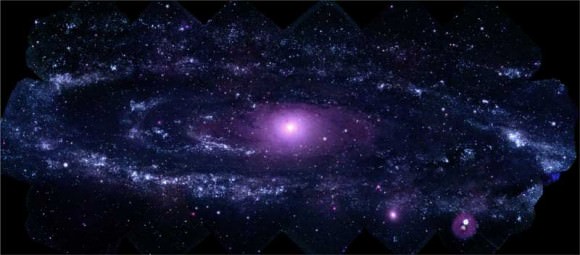
Normally, the Swift satellite is searching for distant cosmic explosions. But recently it took some time to take a long look (total exposure time: 24 hours) with its ultraviolet eyes at the Andromeda galaxy, a.k.a. M31. The result is this gorgeous image. "Swift reveals about 20,000 ultraviolet sources in M31, especially hot, young stars and dense star clusters," said Stefan Immler, a research scientist on the Swift team at NASA's Goddard Space Flight Center. "Of particular importance is that we have covered the galaxy in three ultraviolet filters. That will let us study M31's star-formation processes in much greater detail than previously possible."
Compare this image to an optical version taken by a ground-based telescope:
(...)
Read the rest of Best Ever View of Andromeda in Ultraviolet (157 words)
NASA Science News for September 15, 2009
NASA is set to launch a sensitive new infrared telescope to seek out sneaky
things in the night sky -- among them, dark asteroids that could pose a threat to Earth.
FULL STORY at
http://science.nasa.gov/headlines/y2009/15sep_ninjaastronomy.htm?list1035898
Titan's Haze Acts as Ozone Layer
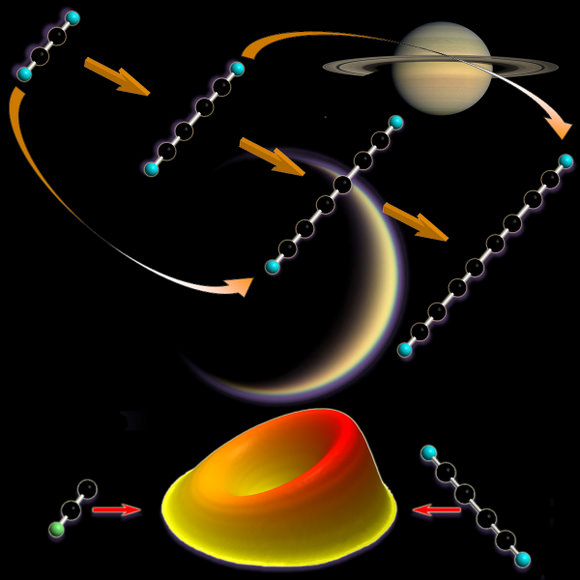
Titan appears to be more like Earth all the time, and a new understanding of Titan's hazy atmosphere could provide clues to the evolution of Earth's early atmospheric environment and the development of life on our home planet. Researchers have discovered a series of chemical reactions on Saturn’s largest moon that may shield the moon’s surface from ultraviolet radiation, similar to how Earth’s ozone layer works. The reactions may also be responsible for forming the large organic molecules that compose the moon’s thick and hazy orange atmosphere.
(...)
Read the rest of Titan's Haze Acts as Ozone Layer (377 words)
Mini Comets Ejected from Comet Holmes Caused Outburst
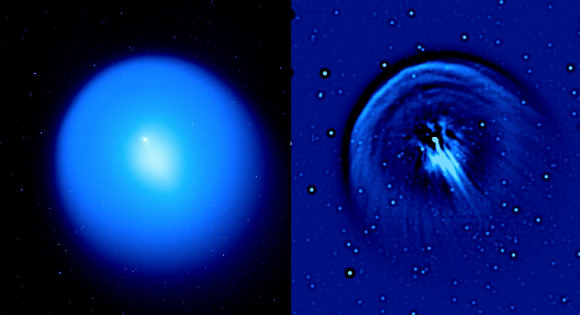
Comet 17P/Holmes caused a sensation in October and November 2007 when overnight, it brightened enough to be visible with the naked eye and became the largest cometary outburst ever witnessed. Using a special filter on the Canada- France- Hawaii Telescope in Hawaii, astronomers were able to peer inside Comet Holmes to determine why the comet became so bright. Images and animations show multiple fragments were ejected and rapidly flew away from the nucleus of comet Holmes.
(...)
Read the rest of Mini Comets Ejected from Comet Holmes Caused Outburst (446 words)
New Wallpaper for Star Trek, Cassini Fans
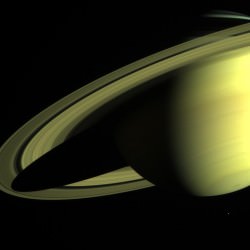
Star Trek fan? Like Cassini and Saturn? The very busy planetary scientist Carolyn Porco also has a visual graphics company, Diamond Sky Productions and they have created some new wallpapers featuring scenes from the latest Star Trek motion picture. The images are copyrighted, so we can't post them here, but no doubt you'll want to take a look at these spectacular images over at Diamond Sky's website. Enjoy!
Super Cell Lightning Storm Raging on Saturn Since January
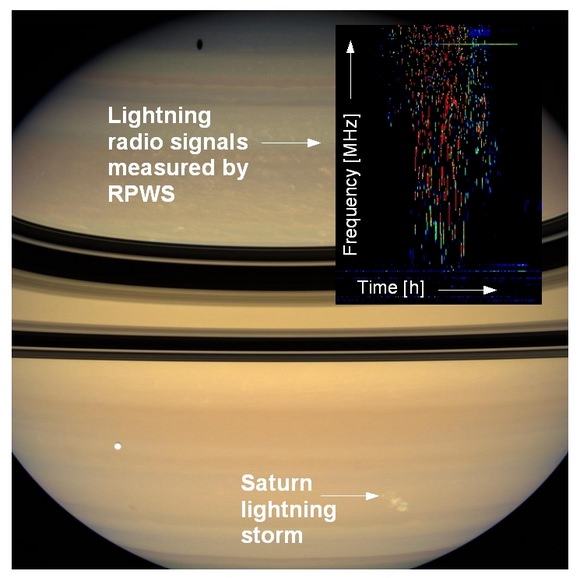
The Cassini spacecraft has been in orbit around Saturn since 2004 and during its mission, has watched nine different lightning storms rage on the planet. But this latest one is the longest lasting and most powerful storm yet: it has been going on since mid-January 2009 with no end in sight. It broke the storm duration record of 7.5 months set by another thunderstorm observed by Cassin between November 2007 and July 2008. Lightning discharges in Saturn's atmosphere emit very powerful radio waves which are about 10,000 times stronger than their terrestrial counterparts and the huge thunderstorms in Saturn's atmosphere have diameters of about 3,000 km.
(...)
Read the rest of Super Cell Lightning Storm Raging on Saturn Since January (353 words)
Interactive 360-Degree Panorama of Entire Night Sky Now Availabl
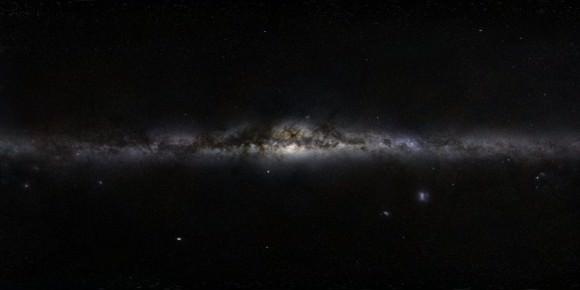
A stunning new 800-million-pixel panorama of the entire sky has been released online for everyone to enjoy. GigaGalaxy Zoom is a project for the International Year of Astronomy, and it allows users to dive right into the Milky Way Galaxy, and learn more about our celestial neighborhood. The project allows stargazers to explore and experience the Universe as it is seen with the unaided eye from ESO’s observing sites in Chile, one of the darkest and best viewing locations in the world.
(...)
Read the rest of Interactive 360-Degree Panorama of Entire Night Sky Now Available (245 words)
